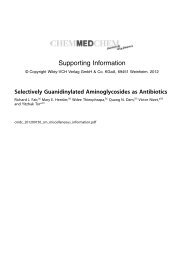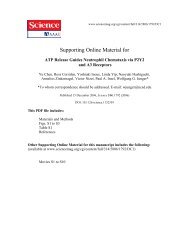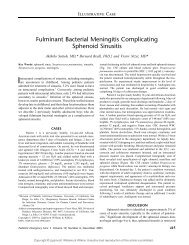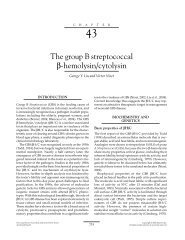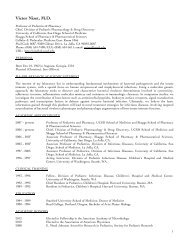BACTERIAL SEPSIS AND MENINGITIS - Nizet Laboratory at UCSD
BACTERIAL SEPSIS AND MENINGITIS - Nizet Laboratory at UCSD
BACTERIAL SEPSIS AND MENINGITIS - Nizet Laboratory at UCSD
Create successful ePaper yourself
Turn your PDF publications into a flip-book with our unique Google optimized e-Paper software.
is a condition in which local inflamm<strong>at</strong>ion can be the only<br />
initial sign of sepsis th<strong>at</strong> can include concurrent meningitis<br />
[474–476].<br />
GASTROINTESTINAL SIGNS<br />
Gastrointestinal disturbances, including poor feeding,<br />
regurgit<strong>at</strong>ion or vomiting, large gastric residuals in<br />
infants fed by tube, diarrhea, and abdominal distention,<br />
are common and significant early signs of sepsis. The first<br />
indic<strong>at</strong>ions of illness can be a change in feeding p<strong>at</strong>tern or<br />
lethargy during feedings.<br />
SKIN LESIONS<br />
Various skin lesions can accompany bacteremia, including<br />
cellulitis, abscess, petechiae, purpuric lesions, sclerema,<br />
erythema multiforme, and ecthyma. These lesions are<br />
described in Chapter 10.<br />
NEUROLOGIC SIGNS<br />
The onset of meningitis in the neon<strong>at</strong>e is accompanied by<br />
identical signs of illness as observed in infants with sepsis.<br />
Meningitis can be heralded by increasing irritability,<br />
alter<strong>at</strong>ion in consciousness, poor tone, tremors, lip<br />
smacking, or twitching of facial muscles or an extremity.<br />
Seizures were present in 31% of the infants reviewed in<br />
Table 6–14, but Volpe [350] identified seizures, in many<br />
cases subtle, in 75% of infants with bacterial meningitis.<br />
Approxim<strong>at</strong>ely half of the seizures were focal, and <strong>at</strong> their<br />
onset, they usually were subtle. Focal signs, including<br />
hemiparesis; horizontal devi<strong>at</strong>ion of the eyes; and cranial<br />
nerve deficits involving the seventh, third, and sixth cranial<br />
nerves, in th<strong>at</strong> order of frequency, can be identified<br />
[350]. Because cranial sutures in the neon<strong>at</strong>e are open<br />
and allow for expansion of the intracranial contents and<br />
for increasing head size, a full or bulging fontanelle can<br />
be absent [448,477]. The presence of a bulging fontanelle<br />
is not rel<strong>at</strong>ed to gest<strong>at</strong>ional age. Among 72 newborns with<br />
gram-neg<strong>at</strong>ive enteric bacillary meningitis, a bulging fontanelle<br />
was seen in 18% of term infants and 17% of preterm<br />
infants [23]. Nuchal rigidity, an important sign in<br />
older children and adults, is uncommon in neon<strong>at</strong>es [23].<br />
In addition to the physical findings observed in infants<br />
with meningitis, several investig<strong>at</strong>ors have reported the<br />
occurrence of fluid and electrolyte abnormalities associ<strong>at</strong>ed<br />
with inappropri<strong>at</strong>e antidiuretic hormone secretion,<br />
including hypon<strong>at</strong>remia, decreased urine output, and<br />
increased weight gain [432,438]. Occasionally, the onset<br />
of meningitis has been followed by a transient or persistent<br />
diabetes insipidus [477].<br />
Early clinical signs of brain abscess in the newborn are<br />
subtle and frequently unnoticed by the physician or parent.<br />
Presenting signs include signs of increased intracranial pressure<br />
(e.g., emesis, bulging fontanelle, enlarging head size,<br />
separ<strong>at</strong>ed sutures), focal cerebral signs (e.g., hemiparesis,<br />
focal seizures), and acute signs of meningitis. Of six infants<br />
with brain abscesses described by Hoffman and colleagues<br />
[429], two were febrile, two had seizures, and five had<br />
increased head size. Other focal infections in the nervous<br />
system include pneumococcal endophthalmitis in a neon<strong>at</strong>e<br />
with meningitis [478], pseudomonal endophthalmitis in a<br />
CHAPTER 6 Bacterial Sepsis and Meningitis<br />
251<br />
prem<strong>at</strong>ure neon<strong>at</strong>e with l<strong>at</strong>e-onset sepsis [479], and epidural<br />
abscess caused by S. aureus in 3-week-old [480], 4-week-old<br />
[481], and 7-week-old infants [482].<br />
DIAGNOSIS<br />
The diagnosis of systemic infection in the newborn is<br />
difficult to establish on the basis of clinical findings alone.<br />
A history of one or more risk factors for neon<strong>at</strong>al sepsis<br />
associ<strong>at</strong>ed with the pregnancy and delivery often is associ<strong>at</strong>ed<br />
with early-onset infection, but there can be no<br />
clues before the onset of subtle signs in a term infant<br />
who develops l<strong>at</strong>e-onset sepsis. The extensive list of conditions<br />
th<strong>at</strong> must be considered in the differential diagnosis<br />
for the various signs th<strong>at</strong> are associ<strong>at</strong>ed with sepsis or<br />
meningitis and noninfectious conditions is presented in<br />
Table 6–15. <strong>Labor<strong>at</strong>ory</strong> tests to assist in the diagnosis of<br />
sepsis are discussed in Chapter 36.<br />
MATERNAL HISTORY<br />
Many infants, particularly infants born prem<strong>at</strong>urely, who<br />
develop systemic infection just before or shortly after<br />
delivery are born to women who have one or more risk<br />
fe<strong>at</strong>ures for early-onset sepsis in their infants. These fe<strong>at</strong>ures<br />
include preterm labor, prem<strong>at</strong>ure rupture of the<br />
membranes <strong>at</strong> any time during gest<strong>at</strong>ion, prolonged rupture<br />
of membranes, chorioamnionitis, prolonged labor,<br />
intrauterine scalp electrodes, and traum<strong>at</strong>ic delivery.<br />
The following fe<strong>at</strong>ures are identified by the American<br />
College of Obstetrics and Gynecology (ACOG) as the<br />
basis for identific<strong>at</strong>ion of women who should receive<br />
intrapartum antibiotic prophylaxis to prevent early-onset<br />
group B streptococcal disease:[483,484]<br />
1. Anten<strong>at</strong>al coloniz<strong>at</strong>ion with GBS<br />
2. Unknown group B streptococcal coloniz<strong>at</strong>ion<br />
st<strong>at</strong>us and<br />
a. Preterm labor (



